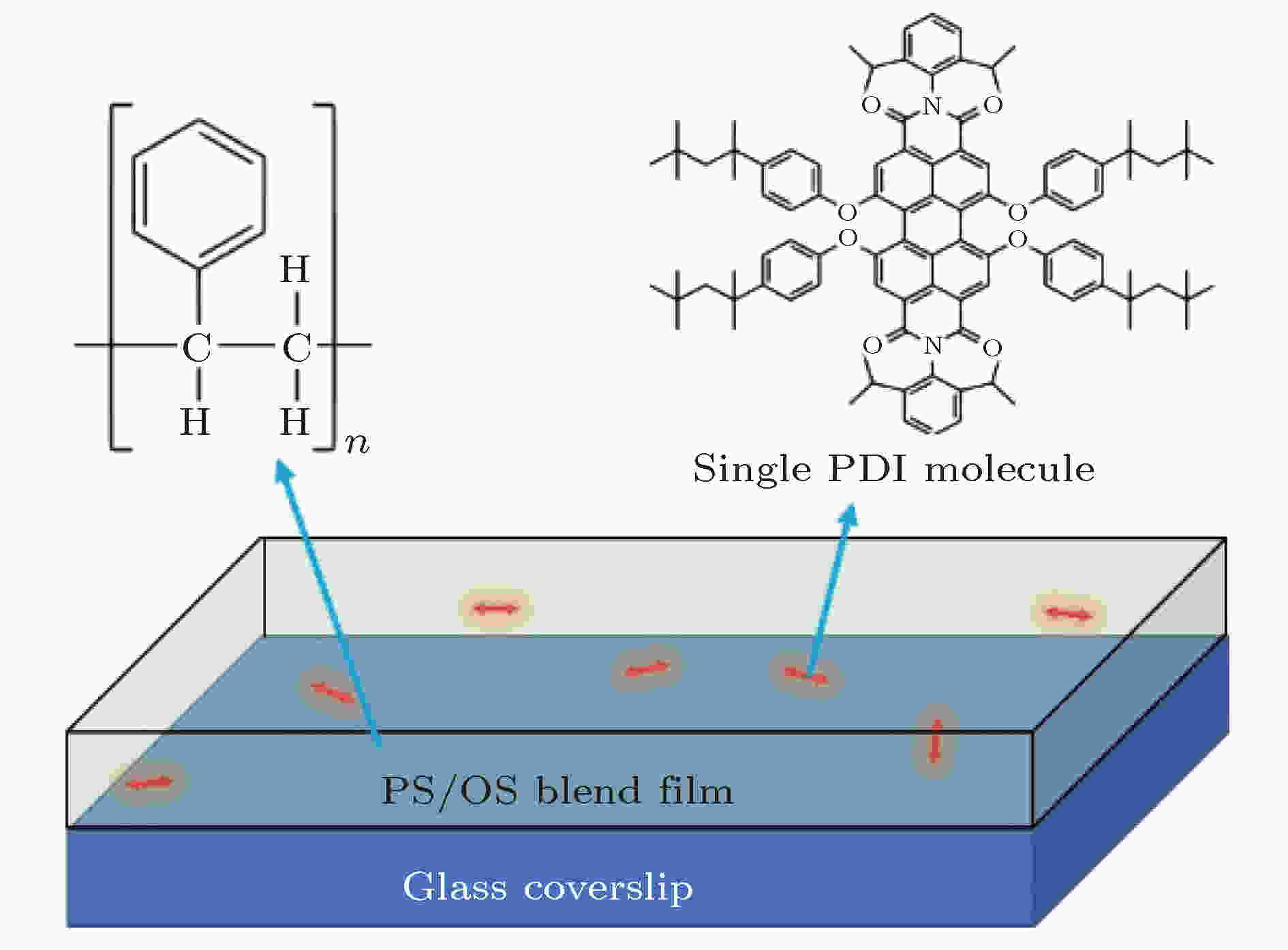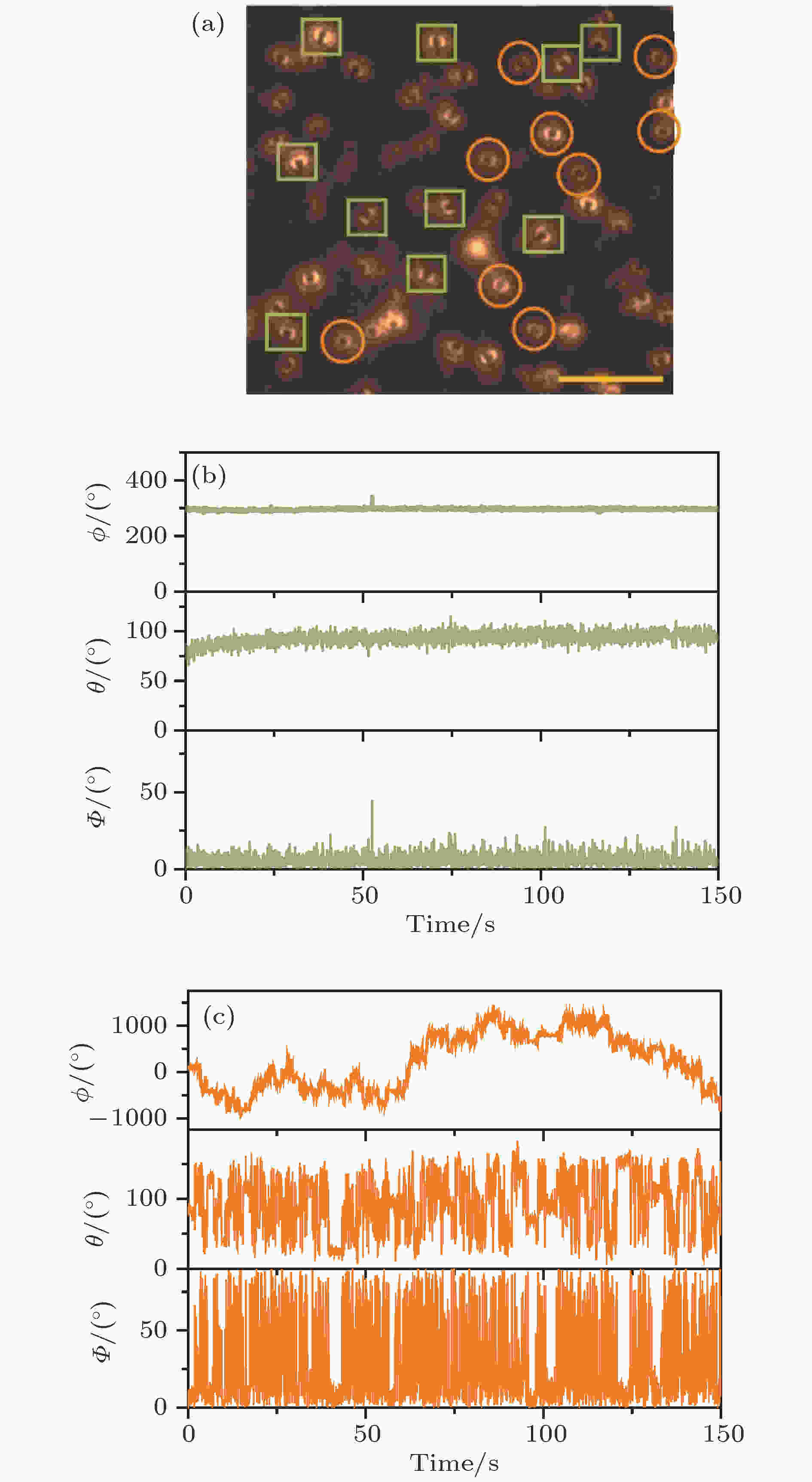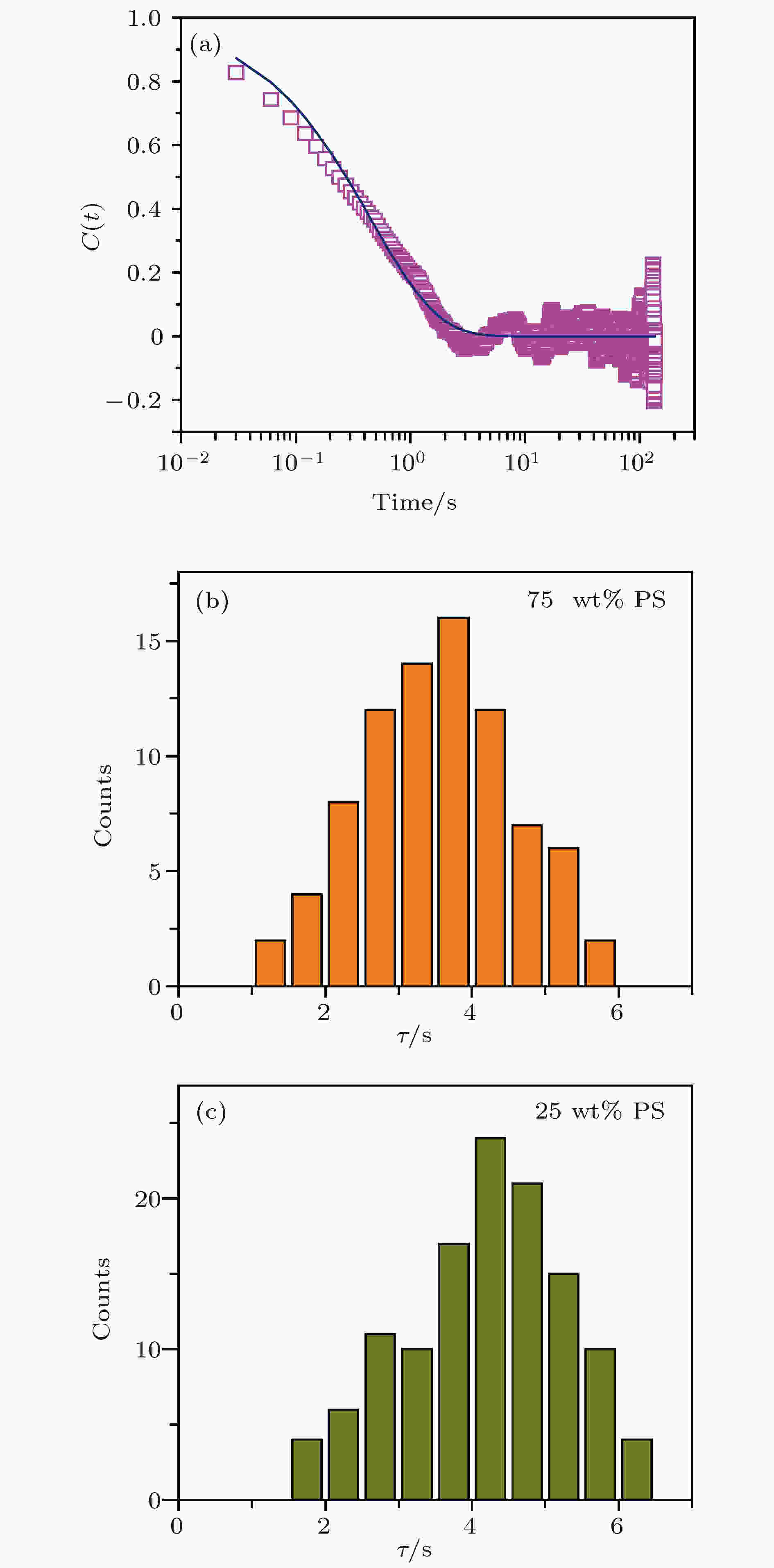全文HTML
--> --> -->传统上认为易混聚合物应该具有一个玻璃化转变温度(glass-transition temperature, Tg), 但实际研究发现易混聚合物的Tg会出现极大的展宽[11], 甚至在一些极端情况下, 如构成易混聚合物的两种聚合物的Tg差别较大时, 易混聚合物中会出现两个Tg[12—15]. Tg差别较大的两种聚合物形成的易混聚合物通常被称为动力学不对称的易混聚合物. 介电谱等系综研究方法显示在动力学不对称的易混聚合物中存在着一个较快的动力学弛豫过程和一个较慢的动力学弛豫过程, 分别为具有较低Tg的聚合物链的动力学弛豫和具有较高Tg的聚合物链的动力学弛豫[16]. 随着实验温度的降低或具有较高Tg的聚合物浓度的增加, 具有较低Tg的聚合物链的动力学弛豫会变得更快, 这是由于降低温度或增加浓度会导致较高Tg的聚合物链变得更加的刚性, 或形成更小的受限区域产生更强的限制作用, 使得较低Tg的聚合物链产生更快的动力学弛豫[3,14,17]. 混聚物的自浓度模型(self-concentration model)理论指出, 在易混聚合物中较高Tg的聚合物链将形成含有微腔的刚性玻璃结构, 而较低Tg的聚合物链将被限制在纳米尺度的微腔中[1,18,19]. 在相同温度下, 限制在微腔中的聚合物比其自由母体聚合物具有更快的动力学弛豫特性, 并且随着受限区域的减小其内部的聚合物动力学会变得更快, 这种现象称为易混聚合物的限制效应[3,20,21]. 在纳米管、微孔等受限区域对其他各种材料的限制效应也已经被广泛研究[22,23]. 介电谱等系综研究方法只能通过随温度变化的聚合物动力学平均弛豫特性来反映限制效应的存在, 但是不能呈现受限区域的分布、尺度及在受限区域中聚合物的动力学分布特征等.
单分子光谱方法能够消除系综平均, 可以探测纳米尺度上的物质结构和动力学信息[24—28]. 单分子作为纳米光学探针能够耦合到聚合物的片段上随着聚合物链的弛豫而发生转动, 从而可以揭示聚合物片段的弛豫动力学特性[29—31]. 单分子散焦宽场荧光显微成像能够获得单分子偶极取向的三维演化的信息[32,33], 已经被用于揭示隐藏在系综平均中的聚合物的时间和空间的动力学异构特性[34—36].
本文利用单分子散焦宽场荧光成像方法探测苯乙烯高聚物与苯乙烯寡聚物形成的易混聚合物中的受限纳米区域的动力学特性. 单分子光学探针能够分别耦合到苯乙烯高聚物和苯乙烯寡聚物的聚合物链的片段上, 探测该易混聚合物中的两种聚合物片段的弛豫特性, 从而可以揭示受限区域的分布特性. 通过分析单分子偶极取向的转动自关联函数, 可以获得受限区域中聚合物的动力学分布情况. 通过结合易混聚合物的自浓度理论模型和分子动力学模拟结果, 可以推测苯乙烯高聚物与苯乙烯寡聚物形成的混聚物中受限区域的尺度并解释实验观察到的各种单分子动力学行为.
2.1.样品制备
实验研究所用的苯乙烯高聚物(polystyrene, Mw = 7150 g/mol, Tg = 363 K)室温下为白色粉末状, 苯乙烯寡聚物(oligostyrene, Mw = 370 g/mol, Tg = 240 K)室温下为黏稠状的流体, 其分子结构如图1上方的插图所示. 这两种聚合物已经被证明具有非常好的“易混”性[16], 且它们的Tg具有非常大的差别 (ΔTg = 123 K), 从而导致非常强的动力学不对称性. 将溶解在甲苯溶剂中的苯乙烯高聚物与苯乙烯寡聚物分别按质量分数比例为75%∶25%和25%∶75%来制备. 有机染料perylene diimide derivative (PDI)单分子被用作纳米光学探针, 其分子结构也显示在图1上方的插图中. PDI单分子具有很好的光学稳定性和亮度, 非常适合于对聚合物薄膜动力学的长时间探测[34,35]. 将苯乙烯高聚物与苯乙烯寡聚物的混聚物制备成浓度为5 wt.%的易混聚合物溶液, 将同样溶解在甲苯中的PDI单分子加入到该混合液中. 甲苯是PDI分子、苯乙烯高聚物和寡聚物的良溶剂, 保证了该混合溶液的均匀性. 最后进一步加入甲苯溶剂将易混聚合物的浓度稀释至1 wt.%, 得到PDI单分子的最终浓度约为10–9 mol/L, 该单分子浓度可以保证制备成膜后单分子的分散性为0.1/μm2, 满足单分子的实验测量要求. 将制备好的混合液以3000 r/min的转速旋涂于清洗过的盖玻片上, 形成厚度约300 nm的掺杂有PDI单分子的易混聚合物薄膜, 该厚度的薄膜可以保证绝大多数的单分子不受聚合物薄膜的表面及其与玻片的界面的影响, 且不影响散焦成像测量. 将制备好的样品放置于温度约100 ℃的真空环境下约3.5 h并自然冷却, 通过该退火处理过程可以消除聚合物薄膜中残余的甲苯溶剂和聚合物薄膜中的张力. 图 1 含有PDI单分子光学探针的苯乙烯高聚物与苯乙烯寡聚物形成的易混聚合物薄膜样品示意图, 上方插图为苯乙烯高聚物(PS, n ≈ 65)、苯乙烯寡聚物(OS, n ≈ 3)和PDI单分子的分子结构
图 1 含有PDI单分子光学探针的苯乙烯高聚物与苯乙烯寡聚物形成的易混聚合物薄膜样品示意图, 上方插图为苯乙烯高聚物(PS, n ≈ 65)、苯乙烯寡聚物(OS, n ≈ 3)和PDI单分子的分子结构Figure1. Schematic view of experimental samples of polystyrene/oligostyrene blend films with PDI single molecules. The above inserts are the chemical structures of polystyrene, oligostyrene and PDI dye molecule, respectively
2
2.2.单分子散焦成像实验装置
单分子散焦宽场荧光成像显微实验装置示意图如图2(a)所示. 该实验装置的主体为一台倒置荧光显微镜(Olympus, IX71). 波长为532 nm的连续激光器(MLL-III-532, Changchun)作为单分子样品的激发光源. 激发光束经过λ/2和λ/4波片后形成圆偏振光后通过一个10 × 扩束器进行扩束, 扩束后的激发光经过一个焦距为500 mm的透镜聚焦在显微镜的物镜(100 × oil, NA = 1.3, Olympus)的后焦面上. 激发光经过一个窄带激发滤波片(ZET532/10 ×)滤波, 被二向色镜(ZT532rdc, Chroma)反射进入显微镜物镜. 通过调节显微镜后方入口处的两个反射镜使激发光以全内反射的方式激发放置于载物台上的恒温器内的样品. 显微镜物镜收集单分子荧光后通过二向色镜、长通发射滤波片(ET542lp, Chroma)进行滤波, 再通过一个3.3 × 的成像透镜放大后进入电子倍增电荷耦合相机(EMCCD, ProEM512B, Princeton Instruments)进行单分子荧光成像. 通过将物镜从焦平面的位置向样品移动~1 μm可以获得单分子的散焦成像, 成像区域为24.6 μm × 24.6 μm. 成像的积分时间设置为30—100 ms, 采集的成像序列达5000帧. 设置恒温器的温度为296 K, 整个实验测量过程中样品置于高纯的氮气环境中以抑制单分子的光漂白延长单分子的测量时间. 图 2 (a)单分子散焦宽场荧光成像显微镜实验装置示意图; (b)单分子的跃迁偶极矩可以由面内角(?)和面外角(θ)来表示; (c)单分子的跃迁偶极矩的三维角位移(Φ); (d)不同?和θ所对应的单分子散焦成像和每一行内的平均散焦成像
图 2 (a)单分子散焦宽场荧光成像显微镜实验装置示意图; (b)单分子的跃迁偶极矩可以由面内角(?)和面外角(θ)来表示; (c)单分子的跃迁偶极矩的三维角位移(Φ); (d)不同?和θ所对应的单分子散焦成像和每一行内的平均散焦成像Figure2. (a) Schematic of single-molecule defocused wide-field fluorescence microscopy; (b) transition dipole moment of single PDI molecule presented by using in-plane (?) and out-of-plane (θ) angles; (c) 3D angular displacement (Φ); (d) defocused patterns of single molecules for different ? and θ angles as well as an averaged image for each row.
单分子散焦宽场荧光成像可以通过跟踪单分子偶极取向的变化来获得混聚物薄膜动力学信息. 单分子偶极取向可以由面内角(?)和面外角(θ)表示, 如图2(b)所示, 不同单分子散焦成像对应于不同?和θ角. 利用基于MATLAB编写的散焦成像程序对实验获得的散焦成像进行模式匹配可以获得单分子取向的?和θ角, 通过拟合该单分子成像序列可以获得?和θ角随时间演化的曲线. 同一个单分子的相邻的两次偶极取向的夹角被称为单分子偶极取向的三维角位移(Φ), 如图2(c)所示. 通过对cosΦ进行自关联函数分析可以获得单分子的转动关联时间来表征聚合物的动力学特征.
3.1.纯的苯乙烯高聚物和苯乙烯寡聚物薄膜中的单分子动力学
首先分别测量了苯乙烯高聚物和苯乙烯寡聚物薄膜中的单分子动力学作为对照实验. 苯乙烯高聚物和苯乙烯寡聚物薄膜中的单分子散焦成像如图3(a)和图3(b)所示, 这两个散焦成像分别由100个各自的单帧成像叠加形成, 可以直观地反映单分子在苯乙烯高聚物和苯乙烯寡聚物薄膜中的不同的动力学行为. 在图3(a)中, 叠加形成的单分子散焦成像与图2(d)中的单帧成像相似, 这是因为296 K的实验温度远低于苯乙烯高聚物363 K的Tg, 在该实验温度下苯乙烯高聚物的片段不具有转动弛豫, 单分子被完全固定在苯乙烯高聚物薄膜中不能发生任何的转动行为. 在图3(b)中, 苯乙烯寡聚物薄膜中单分子散焦成像叠加形成圆环状, 与图2(d)中的平均成像类似. 这是因为296 K的实验温度远高于苯乙烯寡聚物240 K的Tg, 在该实验温度下苯乙烯寡聚物的片段具有快速的动力学弛豫, 耦合在苯乙烯寡聚物片段上的单分子随着苯乙烯寡聚物的动力学弛豫发生快速的转动[34]. 因此由100个不同取向的单帧散焦成像叠加形成类似于平均成像的散焦图像. 总之, 在296 K的实验温度下苯乙烯高聚物片段不发生任何弛豫而苯乙烯寡聚物片段一直发生快速的动力学弛豫. 图 3 (a) 苯乙烯高聚物薄膜中的单分子散焦宽场荧光成像; (b)苯乙烯寡聚物薄膜中的单分子散焦宽场荧光成像; 以上的两个散焦成像都由100个单帧的成像叠加形成的, 可以直观地显示单分子在苯乙烯高聚物和苯乙烯寡聚物薄膜中的不同的动力学行为(图中标尺为4 μm)
图 3 (a) 苯乙烯高聚物薄膜中的单分子散焦宽场荧光成像; (b)苯乙烯寡聚物薄膜中的单分子散焦宽场荧光成像; 以上的两个散焦成像都由100个单帧的成像叠加形成的, 可以直观地显示单分子在苯乙烯高聚物和苯乙烯寡聚物薄膜中的不同的动力学行为(图中标尺为4 μm)Figure3. Defocused images of single molecules in a pure polystyrene film (a) and a pure oligostyrene film (b). Each image is formed by accumulating 100 frames of a defocused imaging sequences (scale bar is 4 μm)
2
3.2.苯乙烯高聚物与苯乙烯寡聚物的易混聚合物薄膜中的单分子动力学
通过单分子散焦成像方法测量了单分子在苯乙烯高聚物与苯乙烯寡聚物的易混聚合物薄膜中的动力学, 实验发现易混聚合物薄膜中同时存在“固定不动”和“转动”的两种动力学形式的单分子, 如图4所示. 图4(a)为苯乙烯高聚物与苯乙烯寡聚物的易混聚合物薄膜中单分子散焦成像叠加而成的图像, 图中分别用方框和圆圈标记出部分具有两类动力学形式的单分子. 用方框标记的单分子的?, θ和Φ角随时间变化轨迹曲线如图4(b)所示, 可以看到?, θ和Φ角的时间轨迹曲线几乎保持不变, 表示单分子取向固定不动. 用圆圈标记的单分子的?, θ和Φ角的时间轨迹曲线显示在图4(c)中, 可以看到?, θ和Φ角的轨迹曲线随着时间不断地发生变化, 特别是Φ角在单位时间内显示出非常大的角位移, 指示着一个转动的单分子. 这些在易混聚合物薄膜中观察到的“固定不动”和“转动”的单分子分别与在纯的苯乙烯高聚物和纯的苯乙烯寡聚物薄膜中的单分子动力学行为非常相似. 根据混聚物的自浓度模型理论, 在易混聚合物中较高Tg的苯乙烯高聚物将形成类似微腔的刚性玻璃结构, 而具有较低Tg的苯乙烯寡聚物将被限制在纳米尺度的微腔中保持着快速的弛豫[1]. 因此我们观察到的“固定不动”的单分子应该耦合在苯乙烯高聚物片段上, 而“转动”的单分子应该耦合到苯乙烯寡聚物的片段上. 这些“转动”的单分子随机地分布在该易混聚合物薄膜中揭示了易混聚合物薄膜中的受限区域的随机分布特征. 在苯乙烯高聚物占比为75 wt.%的易混聚合物薄膜中我们观察到大约有35%的转动的单分子, 而在苯乙烯高聚物占比为25 wt.%的易混聚合物薄膜中我们观察到大约有70%的转动的单分子, 说明易混聚合物中更高浓度的苯乙烯寡聚物成分将诱导产生更多的苯乙烯寡聚物片段区域, 该实验结果符合自浓度模型的理论预期[1]. PDI单分子的尺度大约为2 nm, 因此可以探测发生在该尺度下的聚合物局域动力学; 另外分子动力学理论模拟指出苯乙烯高聚物与苯乙烯寡聚物形成的易混聚合物薄膜中的受限区域的尺度约为2 nm[16]. 因此, 根据观察到的单分子的转动情况我们可以推测该易混聚合物薄膜中的受限区域的尺寸应该在单分子的尺度量级上. 图 4 (a)苯乙烯高聚物与苯乙烯寡聚物的易混聚合物薄膜中的单分子散焦宽场荧光成像, 该散焦成像都由100个单帧的成像叠加而成, 成像图中存在两类动力学形式的单分子, 分别用方框和圆圈所标记(图中标尺为6 μm); (b) 方框所标记的单分子?, θ和Φ角的时间轨迹曲线, 表示为固定不动的单分子; (c) 圆圈所标记的单分子的?, θ和Φ角的时间轨迹曲线, 表示为连续转动的单分子
图 4 (a)苯乙烯高聚物与苯乙烯寡聚物的易混聚合物薄膜中的单分子散焦宽场荧光成像, 该散焦成像都由100个单帧的成像叠加而成, 成像图中存在两类动力学形式的单分子, 分别用方框和圆圈所标记(图中标尺为6 μm); (b) 方框所标记的单分子?, θ和Φ角的时间轨迹曲线, 表示为固定不动的单分子; (c) 圆圈所标记的单分子的?, θ和Φ角的时间轨迹曲线, 表示为连续转动的单分子Figure4. (a) Defocused images of single molecules in a polystyrene/oligostyrene blend film, and the image was formed by accumulating 100 frames of a defocused imaging sequences, two typical rotational diffusion behaviors of single molecules in the polystyrene/oligostyrene blend films were marked with square and circle, respectively (scale bar is 6 μm); (b) ?, θ, and Φ as a function of time indicating the behavior of an immobile molecule; (c) ?, θ, and Φ as a function of time indicating the behavior of a rotational molecule
2
3.3.易混聚合物薄膜中受限纳米区域中的动力学
我们通过测量易混聚合物薄膜中单分子的转动关联时间(τc)来研究受限纳米区域中的聚合物动力学. 首先根据图4(c)中的Φ角的时间轨迹曲线计算











 图 5 (a)在混聚物薄膜中的转动单分子的转动自关联函数及其拟合曲线; (b) 在苯乙烯高聚物占比为75 wt.%的易混聚合物薄膜中的单分子的转动关联时间(τc)的统计柱状图; (c) 在苯乙烯高聚物占比为25 wt%的易混聚合物薄膜中的单分子的τc的统计柱状图
图 5 (a)在混聚物薄膜中的转动单分子的转动自关联函数及其拟合曲线; (b) 在苯乙烯高聚物占比为75 wt.%的易混聚合物薄膜中的单分子的转动关联时间(τc)的统计柱状图; (c) 在苯乙烯高聚物占比为25 wt%的易混聚合物薄膜中的单分子的τc的统计柱状图Figure5. (a) Rotational autocorrelation function of a single molecule in the polystyrene/ oligostyrene blend films, and a fitting with KWW stretched exponential function; (b) histogram of correlation times (τc) of single molecules in blend film with 75 wt.%; (c) histogram of τc of single molecules in blend film with 25 wt.%
总之, 虽然苯乙烯高聚物与苯乙烯寡聚物能够形成完美易混的混聚物[16], 但是我们在实验上仍观察到转动与固定不动两类动力学形式的单分子, 指示着这两类聚合物形成的混聚物在纳米尺度上仍然存在着微相分离, 这恰恰与自浓度理论模型所预期的一致. 由于链连通效应, 在易混聚合物中任意选定的聚合链片段附近的局部组成中总是富含着同类的聚合物[1—3,18,19]. 因此, 在苯乙烯高聚物片段附近的局部区域具有更丰富的苯乙烯高聚物, 而在苯乙烯寡聚物片段附近的局部区域具有更丰富的苯乙烯寡聚物. 分子动力学模拟显示苯乙烯寡聚物片段的动力学尺度约为2 nm[16], 指示着苯乙烯寡聚物受限区域尺度为2 nm. 另外根据自浓度理论模型, 在该易混聚合物中苯乙烯高聚物链将形成含有类似于微腔的刚性玻璃结构, 而苯乙烯寡聚物将被限制在苯乙烯高聚物形成的这类纳米尺度的微腔中. 随着苯乙烯高聚物浓度的增加, 会导致该混聚物中苯乙烯高聚物形成更小的受限区域, 从而产生更强的限制作用, 使得苯乙烯寡聚物链产生更快的动力学弛豫. 因此, 在苯乙烯高聚物为75 wt.%的混聚物中我们观察到了更快的单分子动力学特征.
